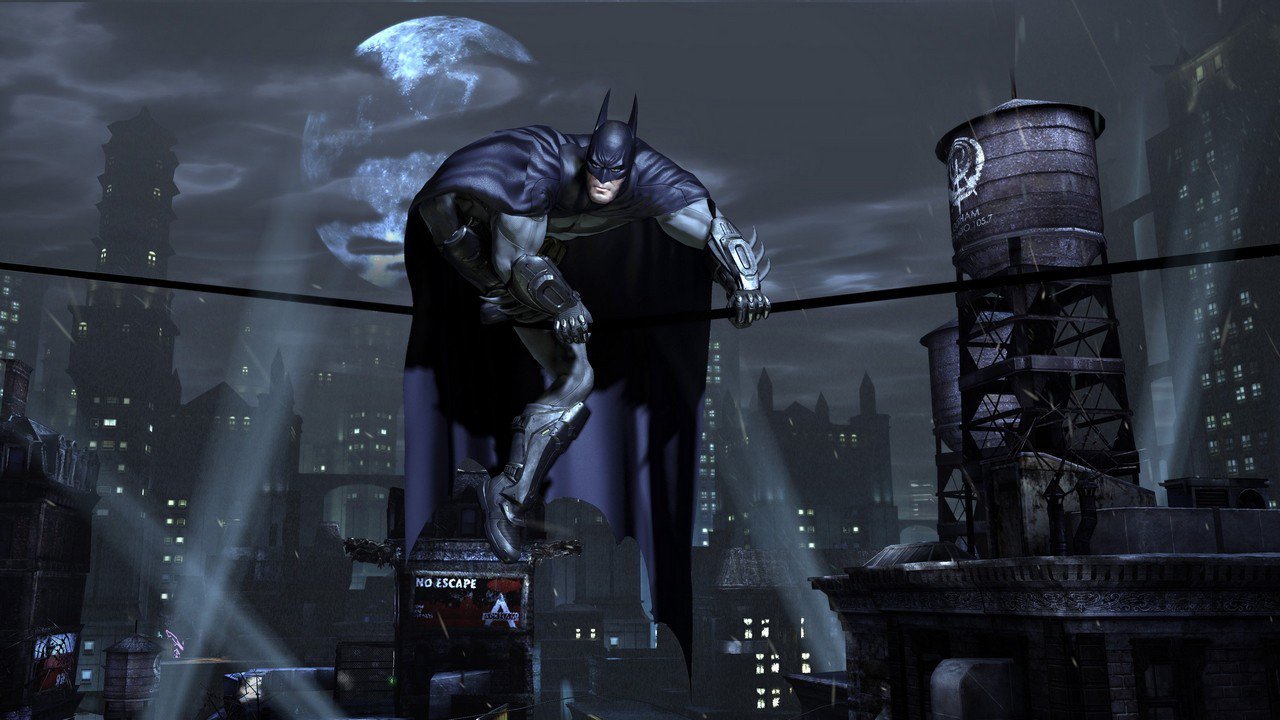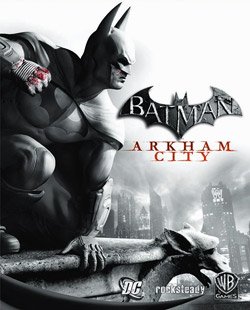When Batman: Arkham Asylum first released in the summer of 2009, it had a lot going against it. Rocksteady was a largely unproven developer, and there was a long legacy of terrible games based on comic properties, with Batman himself being one of the more visible examples. The naysayers and doubters—myself among them—were all proven tremendously wrong from start to finish, as the game showed itself to be not just a top quality game, but a loving, accurate rendition of the Dark Knight that just felt right to both hardcore fans, and casual acquaintances of the Batman property. Now, two years later, Batman: Arkham City has, in some ways, even more going against it; incredibly high expectations, and the dangers inherent in any sequel following up a big success without falling into repetition. It succeeds.
Gotham’s Time Has Come
Batman: Arkham City takes place one year after the original. The former deluded head of the asylum, Quincy Sharp, has gone on to become Mayor of Gotham, with his first act to close down both Arkham Asylum and Blackgate Penitentiary and create a cordoned off super-prison in Gotham’s slum area known as Arkham City. Bruce Wayne surprises everyone by throwing his money—and personal influence—into the political arena to crusade against Arkham City and have it shut down. It is during this campaigning that he is arrested and brought into the facility, and, being Batman, proceeds to go to work as only he can from within the heart of the evil. The story, crafted by both Rocksteady heads and Batman: The Animated Series alumni Paul Dini, takes a lot of twists, turns and quite a few surprises before winding down to a conclusion that will definitely have fans talking. As comic book stories go, this is definitely one of the better ones to appear in a game.
Moving into the presentation, the game continues to use the same Unreal engine that its predecessor did—as do many other high profile titles like the Mass Effect and Bioshock series—but it’s been optimized somewhat to take into account the greater scale. Those paying close attention will notice the occasional bit of screen tearing, and some of the infamous texture “pop-in” that’s so characteristic of Unreal-based game engines. However, as with the original, Rocksteady has done a very good job of keeping these instances to a minimum, and really letting the crumbling, gothic architecture of the Gotham slums do a good job of holding player attention. The towers of New York meet the grimy, rot of London in an amalgam that is both impressive in detail and vaguely horrifying in its presentation of an all too possible world of urban decay. When Batman takes a vantage point high over the city, he can see the glimmering lights of Gotham proper with traffic visible on the roads and bridges, and clean office towers; a stark, shimmering contrast to the decrepit slums he’s trapped in. The characters are all modeled in that same gritty aesthetic used in Arkham Asylum with returning characters such as the Joker and Batman looking mostly the way you remember them. Other less iconic DC characters such as Deadshot and Mr. Freeze have unique interpretations though none quite as subtly brutal as the Penguin’s thug-ish makeover. There’s also a lot of great light, as Batman wanders through deserted or ruined buildings with a lot of interplay between light and shadow. The only real visual quirk for fans of the series might be that it seems like whoever was the architect for Gotham city seemed to have standardized the use of gargoyles throughout the interior and exterior of the town.
The audio side also manages to maintain similarly high standards. First, the voice acting manages to get a lot right with the expected pitch perfect delivery from Mark Hamill, reprising his Joker role from the animated series and Kevin Conroy as Batman from the same. There were doubts about Arleen Sorkin’s departure from the role she defined, as Harley Quinn, but Tara Strong (who some JRPG fans might better recognize as Rikku from Final Fantasy X) manages to provide some startling authenticity. Even Nolan North manages to escape the legacy of Nathan Drake to provide a surprisingly vibrant—and British—Penguin performance. The music is also top notch, invoking much of the feel from the recent Christopher Nolan directed films. It is orchestral, broad and epic in scale, and it matches the tone perfectly. The sound effects are mostly taken from the original game, but now, with added scale of Arkham City to romp through, they have much more space to play in.
It’s What You Do That Defines You
The basic mechanics of Arkham Asylum have carried over into the sequel, but with one major addition; scale. Where the original put Batman on an island and carefully ladled out Batman’s most basic gadgets and abilities, the sequel quickly puts Batman in the center of Arkham City with the ability to traverse it at will. This isn’t a city of the same scale as Liberty City—or any truly open world game, for that matter—but it is a city large enough that it would take several minutes to traverse it solely on foot. By immediately opening things up with a combination of grapnel and gliding, Rocksteady gives players the ability to travel at their whim in an efficient and fun way even managing to work in some devastating new combat moves that consist of literally dive bombing unsuspecting enemies.
That ease of travel is definitely required, because although Batman: Arkham City is still essentially a mix of beat ‘em up and “Metroidvania” style collecting and exploration, there’s been a significant amount of content thrown in for both elements. Side-missions are numerous and spread throughout the city in addition to the main story missions. The Riddler’s trophy and riddle-solving challenges have been opened up to over 400 items, and now include the rescue of hostages. You’ll still be doing much of what you did in the original just a lot more of it, paced across a pseudo-open world, constantly teasing you away from the main story in order to explore or simply learn more lore about the game world, or the DC Universe in general.
The Metroidvania exploration has been considerably expanded, although Rocksteady made the bold risk of not actually taking away skills or gadgets earned in the first game. New obstacles or areas that can’t be accessed are instead the result of new abilities and/or gadgets that Batman has yet to earn. And the larger area of Arkham city means that exploring now takes place both within specific buildings and within the breadth of the prison city itself. Batman’s grapnel ability is now also combined with an ability to glide, not unlike Rico’s grapple/paraglide ability from the Just Cause series, and it means that the exploration takes on a vertical as well as traditional horizontal component. As each new gadget is acquired, access to previously impossible to reach areas becomes possible, provided you remember to go back and look. It adds considerably to the length of the game, though in some ways interferes with the urgency the plot tries to convey.
The combat has also been tweaked, still retaining the same free-flow, timed button system of the first game, with the addition of more gadgets in actual combat, and some new moves that can devastate opponents at the cost of resetting your combo count, creating a tension between score/achievement desires, and efficiency in combat. It’s certainly possible to end a fight by taking out a group of enemies on the ground early in the proceedings, but you’ll do so at the cost of a more respectable score on the leaderboards. The beauty of the combat here is that it’s so unusual in implementation. While button mashing will certainly get a player through most situations mostly intact, careful timing of button presses, use of counters and mixing gadgets and other special moves into the mix results in some devastating attack sequences that rival a Hollywood or comic book choreographed fight. It might not mesh well with everyone, particularly the traditional fighter game aficionados that want a button input to equal a combat move, but it’s consistent with the fiction that Batman is an accomplished fighter who is not going to look like an amateur out in the field. The predation aspect of the combat seems to be the least changed of the elements, although even here, despite Batman not receiving any noteworthy new moves, the enemies are now more versatile in finding him, equipped with night vision and the ability to shoot out vantage points to reduce his points of attack. As with Arkham Asylum combat and predation have their own challenge room sections, where players can compete for trophy/achievement requirements, or simply see who is the most effective combatant in the online rankings.
Finally, there is the story mode itself, which, even if you are trying to avoid the numerous side-missions, is fairly lengthy at an average of about 10 hours the first time through. It’s here that the game suffers in one significant respect compared to its predecessor, and that is pacing. Where Arkham Asylum had a controlled, logical progression that followed a natural arc of rising tension, Arkham City gets off to a good intro, but falters largely through the first half as it tries to justify the larger scope of its environment. The activities are varied, but spread out, with many elements like side-missions and other tutorial elements bogging down the early game. In the second half, with all the “orientation” out of the way, the game really comes into its own, with a good progression to events, abilities, a nice variety of boss fights—something that was a weakness in the original—and a dramatic conclusion to the story.
The secret to Rocksteady’s Batman games seems completely obvious when openly stated, yet it’s something nearly every comic book game fails to do; it makes the player feel like the super hero in question. When you play Arkham City, you ARE Batman. Ultimately, Batman: Arkham City is another strong title for 2011, and quite possibly another game of the year contender. By any critical measurement, it manages to surpass the original both in scope and implementation, though it falters significantly in its initial pacing. For fans of the 3rd person action game, this is one of the best games of the year. For fans of Batman, this may very well be the best game ever. At least until Rocksteady makes a third title. Either way, this is another game that belongs on the must-own list of any serious gamer, or even the mainstream gamer that only wants to own the top titles of the year. This is one of them.






